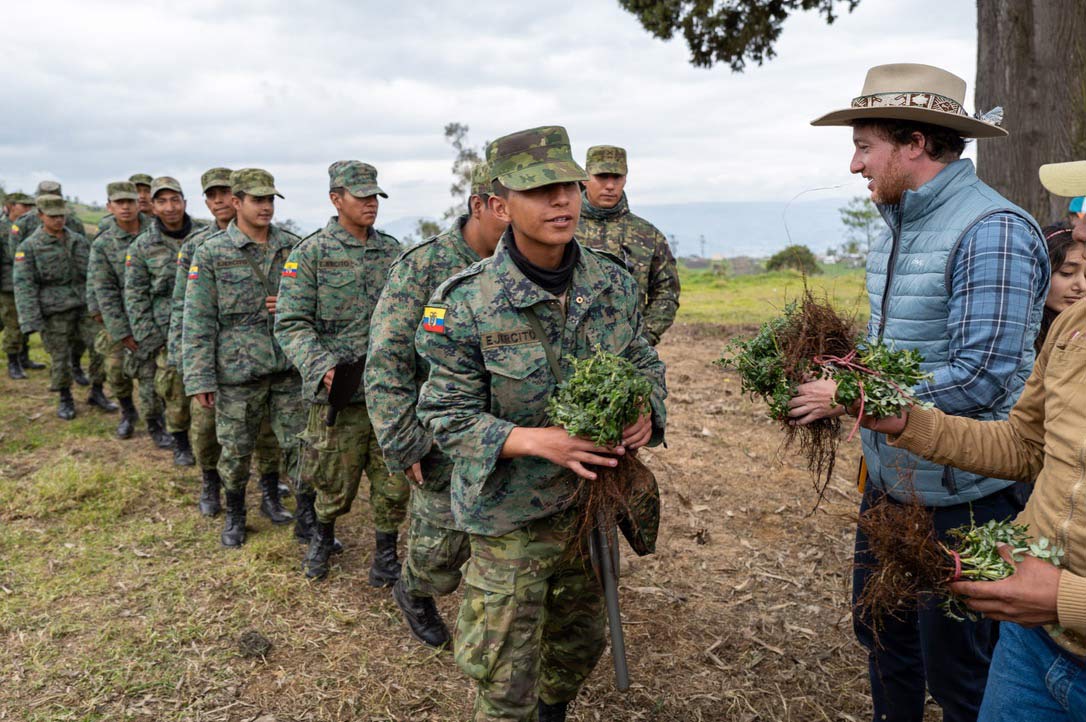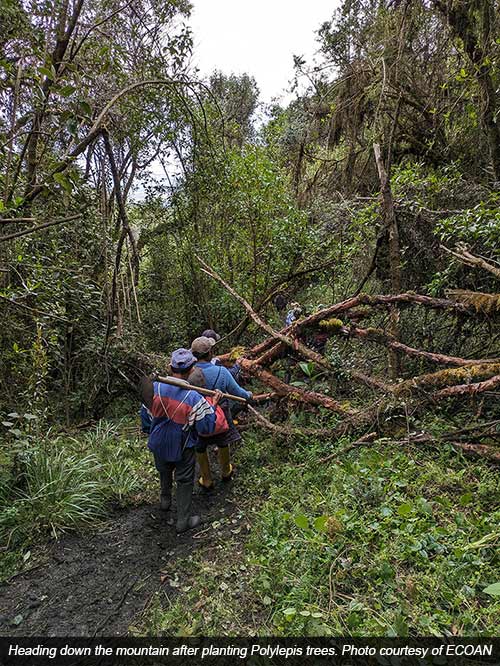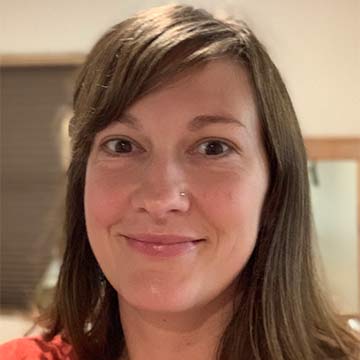Grit and Gumption: Bringing Back Ecuador’s Forests
by Abby P. Metzger
Photo by Todd Brown
Grit and Gumption: Bringing Back Ecuador’s Forests
I’m not going to make it to the top. Ninety minutes into the hike, we’ve just passed the old-growth clearing with 45 minutes still to go. Streams of people are already descending, saplings planted and smiles wide. Grandmothers, children, Indigenous women in hats with bird feathers—all moving with ease through the mud.
At 12,000 feet, my head whines, my breath caught in the shallows of my throat. Even though I regularly exercise and commute on my bike, I’m winded. These lungs and legs live near sea-level, in a valley between two rivers in Oregon. Now, I’m in Ecuador in the shadow of Chimborazo, a girthy and glaciated mountain. Each year, the hem of its icy skirt unravels a bit more.
“Buen día.” Good day, the people say as they pass me on the way back down. “You’re from America?” A man says to me in Spanish. What gave me away? Was it the fly-fishing ball cap and quick-dry pants? Or my pasty skin? “You are rich!” he says. I look down. Maybe not rich, but certainly able to make this trip and witness hundreds of ordinary Ecuadorians plant 40,000 trees in about two hours. I didn’t make it to the top or plant any trees—but what I saw changed how I think about action, community, and what it really takes to bring nature back.
***
Fifteen years ago, I was also part of a nature restoration project—this time by the Willamette River, the major waterway veining through western Oregon. Though there were far fewer volunteers than in Ecuador, we planted cottonwoods, alders, and native shrubs. Back then, I still lived in the heady days of youth where time felt forever. And I spent it asking: How do we know when something is restored? Is ecological restoration like artistic restoration, where we try to return nature’s canvas to its original, unharmed state? Is restoration a kind of justice, to make up for the environmental destruction we’ve caused? And if so, how can nature ever forgive us?
I sometimes miss languishing over metaphors and meaning. Now I worry we are out of time to craft the perfect solution. The hockey stick of the Keeling curve, a graph showing the concentration of carbon dioxide in Earth’s atmosphere over time, slopes ever steeper. Scientists say this is a make-or-break decade. To some degree, this is why I quit my stable job at Oregon State University to work for Global Forest Generation, a young conservation organization that is helping to bring forests and water back to the Andes in South America. Now, it’s action over perfection. Bring the people. Climb the mountain. Plant the trees.
***
I had been sent to Ecuador for my new job, to experience our restoration initiative and witness how local and Indigenous communities are restoring the ecosystems of their mountains.
And here I was at the top of the world, surrounded by Spanish and trying to recall vocabulary from my time studying the language in college and living for periods in Spain and Costa Rica. I did my best when interviewing local conservation leaders about their motivations for restoring the páramo, the unique Ecuadorian highlands. I imagined how I must have sounded to them: “Hi. Please introduce yourself. Why you like this work? Climate change is bad, very very bad. How do you feel about it?”
In the days before the tree-planting event, I traveled with co-workers and companions around the Chimborazo Province of Ecuador, visiting tree nurseries, local communities, wetlands, and more. We talked to engineers and scientists, all looking at how the region is changing in a warming world. The Andean glaciers are melting, which is a bad thing, because they are the birthplace of the Amazon River and supply water to millions of people in South America. Here in Ecuador and across the Andes, conservation leaders have teamed up with local and Indigenous communities to restore highland ecosystems to mitigate the rapid disappearance of these ancestral glaciers.
During one stop, we visit a nursery where the trees we will soon plant are growing. They are called Polylepis trees. I had never heard of them before starting this job. These native high-Andean species, with gnarled branches and papery bark, form the highest treelines in the world. They can withstand the harsh moods of the Andes and live up to 700 years. Polylepis trees also intercept moisture—storing it in their roots and the mosses that grow on them—and then releasing it to recharge downstream wetlands. Yet, across the lengthy spine of the Andes, which extends from Venezuela to ice-glazed Patagonia in the south, only a fraction of these forests remain.
During another stop, we stand by the beginning of the Ambato River, following the path of water as it winds down mountainsides. Chimborazo is capped in clouds. The landscape is harsh: desert scrub and grassland, windy and cold. I feel so out of sorts, like walking the edge of a dream. Things are vastly different; they don’t feel real.
A local community comes to visit, most of them wearing bright-red ponchos. They greet us with handshakes and kisses. Coming and going is a big thing here. We ask the people if it’s going to rain. Not yet, they say. They are right. What I don’t yet know is that a year later, the rains will arrive very late and delay the tree-planting season. Major cities like Quito will endure planned power outages. Without enough water, dams can’t operate at usual capacity. Droughts, melting glaciers, warming temperatures—they are all connected.
Over and over throughout my time in Ecuador, I hear local people say the glaciers are running away, and we need to restore the highlands and replant the forests for water. They don’t need a scientific paper to understand the crisis. Like Fernando Chicaiza, a community leader with sincere round eyes and high cheekbones, who sat by a stream and said: “We can live without electricity. We can live without the internet and other services. But not water.” Or Laura Punina, another community leader, who asked plainly, “¿Qué sería de nosotros sin agua?” What would happen to us if there is no water?
Of course, water is a powerful motivator. But I’m still amazed that hundreds of people here gather to plant trees—despite the whipping wind, the sideways rain, the altitude, the mud. And they don’t just gather here in Ecuador. Across the high Andes, tree-planting festivals like this take place during the rainy season (from roughly November through March). In one record-breaking event, more than 800 people in Aquia, Peru, planted 150,000 Polylepis trees in a single day. Many of the people involved will never live long enough to see these gnarly trees grow past their knees.
I’m told that the ancient Inca concepts of Ayni and Minka are at work here—reciprocity and communal work. Today I help you; tomorrow you help me. There’s no tally or tracking of who owes whom. We do it for the sake of life—for now, and for lives yet to come. For the untold generations.
It reminds me of a concept I read about years ago: Generativity—the ability to look beyond our personal interests and show concern for future generations. Becoming a mother brought an instant and transcendent understanding of generativity. Suddenly all my actions felt like moves on a chess board to create a future where my children will know wildness, where they will feel cold streams biting their ankles and taste the sunset orange of salmon flesh.
Perhaps the people here in Ecuador embody an even deeper form of generativity. Planting a tree is an act of legacy, a deliberate choice to create a future we will never see. It both acknowledges impermanence and commits us to something enduring, something woven into the landscapes and lives of tomorrow.
Throughout the trip, I kept asking myself, how do we adopt this mentality in a capitalistic society, motivated by self-interest and greed? Can Ayni and Minka save the world?
***

Ecuadorian military personnel line up to receive trees for planting. Photo by Todd Brown
On planting day, people crowd an unmarked open field. Even the local military show up, each young man receiving bread, a warm drink, and tools. Their faces are so unlined. I could be their mother. Women in white scarves and crisp hats with green bands dance and sing.
I can smell sweet onions and potatoes cooking, ready for the celebration when the tree-planting is done. Against a grey sky, a girl sits on top of a horse—an Ecuadorian cowgirl. She can’t be more than eight years old, but her eyes are older. On top of that horse, with her crimson wool poncho, she sees the world a few feet higher in this place where the air turns scarce. She doesn’t flinch when I take an extra beat to look at her. What was my own eight-year-old doing, in the flatlands, the grassy plains, the space between two rivers, on the other side of the Equator? Does he remember when we dug holes during the pandemic and planted snowberries by our neighborhood creek?
Everyone suddenly lines up for their bushel of trees. We are here for a collective purpose. Like a braided, icy river knifing down a glacier, we come together in one big torrent to bring back the forests. Even though I don’t yet know that I won’t make it to the top of the mountain, I feel part of a very important movement. Swarms of people from all different backgrounds move together—like a dusky cloud of blackbirds flying in unison across a summer sky. I stand at the edge and wonder what force unites them.
At one time, I would have said it’s hope. I still think back to my thesis defense about river restoration, where I asked if trying to put nature back was an act of hope, or hubris? My advisor smartly asked, “What’s the difference?” I still don’t know. But for many years, I remained moored to the deep belief that hope, like love, was enough to save the world. Now I’m not so sure.
Some have argued that unchecked optimism is part of the problem—a numbing device to keep us sedated from the perfectly understandable sorrow we may feel for ecosystem collapse.
As Ailton Krenak, a Brazilian Indigenous writer and environmentalist, said: “I’m not renouncing hope. But I also don’t want to promote a ‘placebo hope,’ one where you pat someone on the shoulder and say everything will be fine. It won’t be fine. We’re going to get worse for a while. But after that, we can improve, as long as we learn to renounce [materialism and consumption].”
I tend to agree. Sometimes hope feels like sinister gaslighting, convincing us we should feel okay, when it’s important to confront and honor the range of emotions we might have in a world of ecological wounds. Sorrow is a necessary antecedent to healing, and maybe even necessary to ignite action.
***

Everyone is celebrating and smiling, their trees planted. We did it. Well, I didn’t, but nobody seems to know or care that I didn’t make it up the mountain. Men with strong alcohol in unmarked bottles keep insisting I take a drink. The potatoes and chicken are warm and so flavorful. Stray dogs with matted hair beg relentlessly, and I feed as many as I can. I thank the hands that made the food and the ones that planted the trees. I thank the military men for carrying shovels and not guns. I thank the world that I had this experience, despite the deep ache for my family haloing my heart.
Hope. Pragmatism. Generational thinking. Communal spirit. They are all important, maybe essential for restoring nature. But underneath it all, cementing the cosmic psychology necessary for transcendent change, is maybe something far more practical: Grit. You just do it. You start with yes, an assumption of success and then are freed to think creatively about how to do it and not whether it can be done. Gumption. Do it. Just Goddamned do it.
One of the casualties of a so-called developed nation is unnecessary complexity. Byzantine processes, rules and reasons get in the way. It grinds you down, stubbles your creativity. Whether by design or accident, the evolution of society binds us to thinking that some things are simply too hard. But does it have to be?
In Ecuador, I could see a simple model at work. There were leaders like my boss Florent Kaiser and his Indigenous conservation co-lead, Constantino Aucca Chutas. There were executive directors of local conservation groups, leaders of Indigenous communities, and generals of the local military. Behind them, were many, many more helpers—scores of hands ready to dig the holes and plant the trees. The Lauras, the Fernandos, the Ecuadorian cowboys and cowgirls. There were cooks to nourish the people and bring the whole community closer through a shared meal. Even I as a storyteller had a role to play, as a witness to this community’s steadfastness and unified mission. I could be present and alive in this moment, and use my words to amplify their story. I could try and do some good in my backyard, too. I could tell my children about the young ones here planting trees, about the leaders and the many helpers.
***
From the window on my plane ride home, Mt. Hood emerges—my home mountain capped in snow. I feel the weight of both worlds. The one I’m returning to, where water also grows scarce, and the one I left behind in Ecuador—where people plant trees not just with hope, but with grit and resilience.
I think about the hands that carried saplings and the stubborn determination it takes to climb a mountain and plant a tree. It wasn’t optimism alone that brought them there. It was a collective decision to act. To dig in the dirt, to celebrate what remains, and to restore what has been lost.
And maybe that’s what I carry home—a quiet resolve. Not to dwell on whether it’s too late, but to ask, what can I offer today as a gift to the future?
The flatlands of my home are calling. The snowberries I planted with my children are surely taller. There is work to be done. There is more to plant. And like the people of Chimborazo, I know what it takes to climb.

Abby Phillips Metzger is a science communicator, author, paddler, and mother. Prior to her current appointment as the Communications Director for Global Forest Generation, she worked for nearly a decade as a science writer and communicator in the College of Earth, Ocean, and Atmospheric Sciences at Oregon State University. She has also worked in journalism, book publishing, and environmental education. Abby is the author of Meander Scars, a series of essays about river restoration; and a co-editor of Wild in the Willamette, a collection of outdoor adventures within the mid-Willamette Valley watersheds. Her writing was recently recognized as a top pick for the Best Shortform Science Writing and the Best of the Northwest Science Writing Awards. She lives near the Willamette River with her husband and two children.